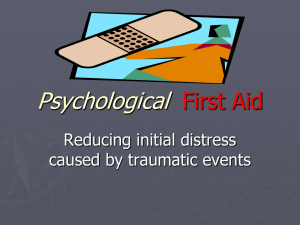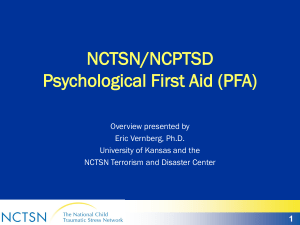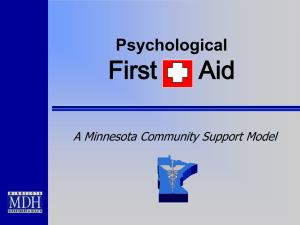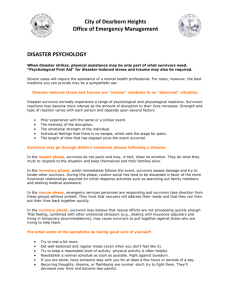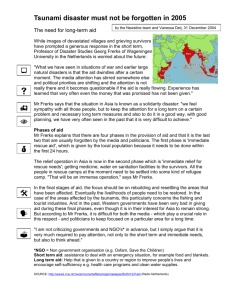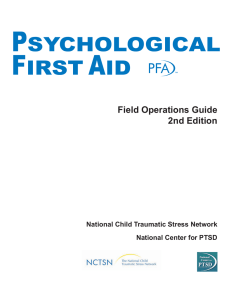PFA Intro November 2013 - Western Massachusetts Medical
advertisement
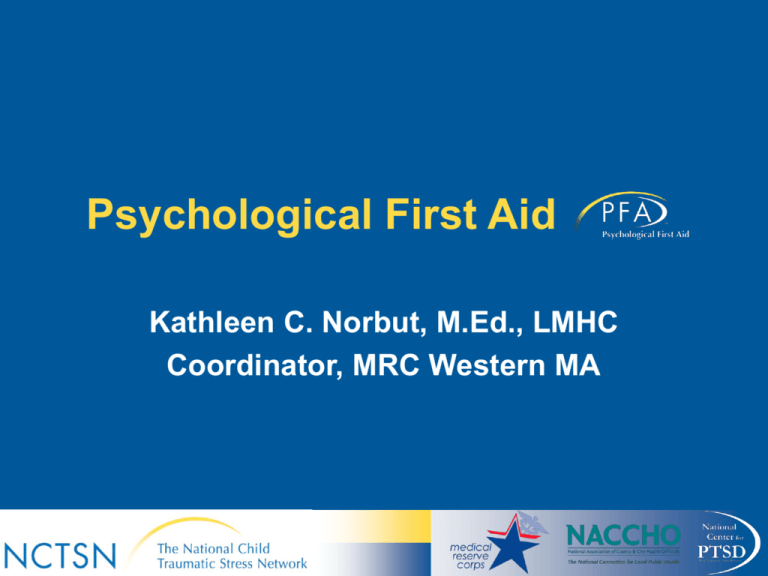
Psychological First Aid Kathleen C. Norbut, M.Ed., LMHC Coordinator, MRC Western MA Logistics and Housekeeping • • • • • Location of restrooms Emergency exits (if appropriate) Cell phone/pager etiquette Registration/sign-in sheet Evaluation forms Learning Objectives • At the end of this course, participants will be able to: – Identify the basic objectives and intervention strategies of Psychological First Aid. – Gain skills needed to implement the intervention strategies of Psychological First Aid. – Adapt Psychological First Aid in diverse settings and with different populations. – Appreciate the importance of providing Psychological First Aid in the aftermath of disaster. – Gain confidence in implementing Psychological First Aid in the immediate aftermath of a disaster. – Identify ways to enhance provider care before, during, and after disaster care. Psychological First Aid Authors • • • • • • • • Melissa Brymer, Ph.D., Psy.D. Ann Jacobs, Ph.D. Christopher Layne, Ph.D. Robert Pynoos, M.D., MPH Josef Ruzek, Ph.D. Alan Steinberg, Ph.D. Eric Vernberg, Ph.D., ABPP Patricia Watson, Ph.D. Medical Reserve Corps Adaptation • • • • • • Abbe Finn, Ph.D. Jack Herrmann, M.S.Ed. John Hickey, Ph.D. Edward Kantor, M.D. Patricia Santucci, M.D. James Shultz, Ph.D. How Do We Know How to Respond Following Disasters? Five Empirically-Supported Early Intervention Principles What is Psychological First Aid? • PFA is: An evidence-informed modular approach to assist children, adolescents, adults, and families in the immediate aftermath of disaster and terrorism. What are PFA’s Principle Actions? • PFA’s principle actions are to: – Establish safety and security – Connect to restorative resources – Reduce stress-related reactions – Foster adaptive short- and long-term coping – Enhance natural resilience (rather than preventing long-term pathology) Who Delivers PFA? • PFA is delivered by disaster response workers who provide early assistance, including: – – – – – – First responders Mental health professionals School personnel Religious professionals Disaster volunteers Health and public health officials Psychological First Aid Core Actions (Dr. Blanck video click above) 1 2 Contact and Engagement Safety and Comfort 3 4 5 6 7 Stabilization Information Gathering Practical Assistance Connection with Social Supports Information on Coping 8 Linkage with Collaborative Services Provider Care: Management • Mandated rotation where workers are moved from the most highly exposed assignments to varied levels of exposure • Enforced support by providing/encouraging: – Regular supervision – Regular case conferences – Peer partners and peer consultation Provider Care: Management (cont.) • Monitor providers who meet certain high risk criteria • Conduct trainings on stress management practices Provider Care: Personal • Limit daily numbers of most severe cases • Utilize the buddy system to share distressing emotional responses • Use benefit time, vacation, personal time • Access supervision routinely • Practice stress management during the workday • Stay aware of limitations and needs Provider Care: Personal (cont.) • Providers should make every effort to avoid: – Working too long by themselves without checking in – Working “around the clock” with few breaks – Feeling like they are not doing enough – Excessive intake of sweets and caffeine Provider Care: Personal (cont.) • Common attitudinal obstacles to self-care: – “It would be selfish to take time to rest.” – “Others are working around the clock, so should I.” – “The needs of survivors are more important then the needs of helpers.” – “I can contribute the most by working all the time.” – “Only I can do x, y, and z.” Provider Care: Following Disaster Response • Expect a readjustment period upon returning home • Discuss the situation with coworkers and management • Participate in formal help if extreme stress persists • Ask help in parenting, if you feel irritable or have difficulties adjusting Provider Care: Following Disaster Response (cont.) • Prepare for worldview changes that may not be mirrored by others in your life • Increase experiences that have spiritual or philosophical meaning to you • Always remember to keep First Things First and take care of You Core Action #1: Contact and Engagement • Establish a connection with survivors in a non-intrusive and compassionate manner – Introduce yourself and describe your role – Ask for permission to talk – Explain objectives – Ask about immediate needs Core Action #2: Safety and Comfort • The goal is to enhance immediate and ongoing safety and provide physical and emotional comfort Core Action #2: Safety and Comfort Acutely Bereaved Individuals • Listen carefully with sympathy • Be informed about cultural norms • Know that grief reactions vary from person to person • Help family members to respect differences in grieving Core Action #2: Safety and Comfort Grief and Spiritual Issues • Ask survivors if they have religious/spiritual needs • Refer them to a clergy member of their choice • Do not judge, contradict, or correct what they say about their religious beliefs • If survivors want to pray, help them find a suitable place Core Action #3: Stabilization • The goal is to calm and orient emotionallyoverwhelmed and distraught survivors Core Action #3: Stabilization Signs a Person May Need Stabilization • • • • • • Glassy eyed and vacant Unresponsive Disoriented Exhibiting strong emotional responses Uncontrollable physical reactions Frantic searching behavior Core Action #3: Stabilization Grounding • Ask the person to: – Listen to and look at you – Orient him/herself to the surroundings – Talk about the aspect of the situation that is under control, hopeful, or positive – Breathe in and out slowly and deeply – Name five non-distressing things he/she can see, hear, and feel Core Action #4: Information Gathering • The goal is to identify immediate needs and concerns, gather additional information, and tailor PFA interventions • It is used to determine: – Need for immediate referral – Need for any additional available ancillary services – Which components of PFA may be helpful Core Action #5: Practical Assistance • Offer practical help to survivors in addressing immediate needs and concerns – Identify the most immediate need – Clarify the need – Discuss an action response – Act to address the need Core Action #6: Connection with Social Support • The goal is to help establish brief or ongoing contacts with primary support persons, such as family members and friends, and to seek out other sources of support Core Action #7: Information on Coping • Provide information about stress reactions and coping to reduce distress and promote adaptive functioning – Explain what is currently known about the event – Inform survivors of available resources – Identify the post-disaster reactions and how to manage them – Promote and support self-care and family care practices Core Action #8: Linkage with Collaborative Services • The goal is to link survivors with available services needed immediately or in the future Core Action #8: Linkage with Collaborative Services Agencies Providing Services • Reconnect survivors to agencies that provided them services before the disaster: – – – – – – – Mental health services Medical services Spiritual support Alternative healers Child welfare services Schools Drug and alcohol support groups Discussion • Group activities – Scenarios and Discussion Be well, Be safe • First Things First • Easy Does It • Comfort, Care, Safety, Stabilization, Security • Use the “buddy system” THANK YOU FOR YOUR SERVICE!
